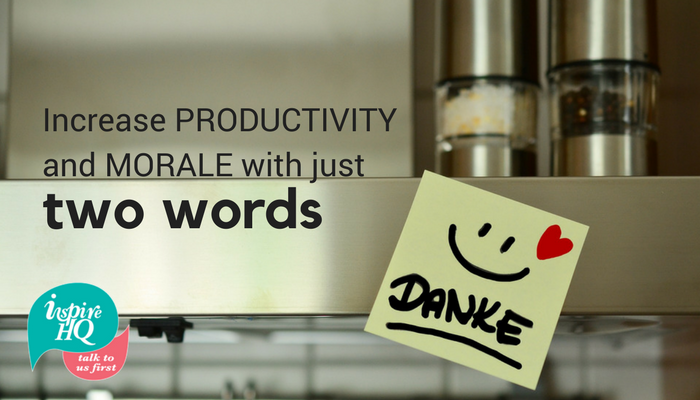Recently a group of us were discussing how we should show appreciation to someone, who we all agreed was doing an exceptional job. I was taken aback when one person said that he felt ‘these sorts of things are a bit unnecessary. It’s your job, just do it’. It isn’t the first time I’d heard such a statement; however, I was surprised to hear it from someone who’s views I normally respect. In my experience showing a little appreciation is one of the most effective ways to boost morale and increase productivity, yet many leaders hesitate in saying even a simple ‘thank you’. Why?
To get a sense of what might cause this apprehensive I conducted some research (ok, so I asked a few friends over coffee). Common views included: ‘If I show appreciation, they might ask for a raise’, ‘If I thank this person, then that person might get disgruntled’ and ‘Shouldn’t they know they are doing a good job without me telling them every other second?’ In all the years I’ve been thanking staff, noone has ever asked for a pay increase and I made sure I don’t play favourites. Feeling recognised and appreciated is a human need. We will naturally want to contribute more when we know our work is valued and making a difference. And as one somewhat disgruntled friend so eloquently put it “instead of them telling me I should be grateful for having a job, they should be grateful that I keep putting up with your lack of appreciation!”.
Benefits of Showing Appreciation
Leaders are looking for ways to increase productivity and morale any way they can. You’d be surprised how much the simple act of appreciation can add value to your bottom line and and help you retain good staff. Research collated by Globoforce shows[1]:
- 67 percent of employees respond positively by management praise alone.
- 78 percent of people would work harder in their jobs if they were regularly recognized.
- 60 percent of employees who don’t get appreciation are actively looking for new jobs.
- 80 percent of employees who feel recognized are staying put in their jobs.
How to Show Appreciation
For anyone who has read any of the thought-provoking work by Lucy Adams and the Disruptive HR Agency, you will be familiar with the EACH model. Employees as Consumers, Adults and Human Beings. In her book ‘HR Disrupted’, Lucy details the growing body of evidence which shows ‘recognising that people want to be thanked and have their work valued in a way that shows real thought, and is meaningful and timely – is powerfully motivating’.[2] Adams goes on to say appreciation needs to be unexpected, thoughtful and human.
Trav Munro, Youth Leadership Speaker and Facilitator agrees, “how a workplace (shows appreciation) is not as important as the knowledge that what they are doing will speak and connect with the recipient’s values. If employers take the time to really know their staff then they will be able to show appreciation at a level that really connects with (the recipient) rather than just a one size fits all approach”.
For anyone who has previously read our blogs (thank you – see, easy!), you’ll know we are waging a war against the ‘one-size-fits-all’ approach to leadership and employee engagement. This means reconsidering the corporate incentives program, bonus schemes and annual appraisals. Often these programs become so onerous to manage, they turn into a complicated spreadsheet in which we need to ‘tick everyone off’, removing the human element altogether.
Five Top Tips For Showing Appreciation
Here are my five key messages for recognising the great work done by your staff, in a way that is meaningful to the person and encourages the desired workplace behaviour:
- Get to know your employees and what motivates them, then tailor your appreciation to their needs. One employee might have carer responsibilities and would value flexible hours or an occasional longer lunch, whereas another might get a kick out of being publicly recognised at your team meeting.
- Make sure the recognition is timely, not six months after it happened at a review meeting. Also don’t wait for a special occasion. Frequent, small acts of appreciation are more likely to be valued and continually reinforce the behaviour or performance you are seeking.
- Be sincere. If you don’t mean it, don’t say it. People know when you are not being authentic.
- Be creative. It doesn’t need to be a big expense to have a big impact. If the employee has a sweet-tooth, leave a cupcake with a note. If they are an active volunteer, make a donation in their name to their chosen charity/organisation. If they are an eager learner, source an upcoming webinar on a topic of interest and give them worktime to participate. I’ve heard of one workplace creating badges that say ‘My Boss Thinks I’m Kind of a Big Deal’, sounds a bit naff, but the staff loved it. Whatever you choose, the important thing is to tailor your approach to the needs of the receiver.
- If all else fails, just say thank you. I’ve lost count of how many conflicts I’ve mediated, that boiled down to a manager not saying, ‘thank you’. For the ‘thank you’ to have meaning it must be specific. ‘Thanks, great job’, isn’t going to be as meaningful as you taking the time to identify the specific actions or behaviours that are appreciated. ‘Thank you for working back last night, it meant we got that part off to the customer early this morning and they just rang to say thanks’.
As I said in one of my previous blogs “Want productive and engaged staff? Treat them like adults – Part 2, Practices“, if you can’t come up with a way that an employee is contributing to the success of your business, then you need to ask yourself if you still need that person or position? We all know culture is king (or queen), sometimes it is your only competitive advantage. By creating a workplace that consistently recognises and appreciates its employees, you’re on your way to building employee loyalty and a strong positive culture.
Claire Huntington has over 15 years’ experience in senior and executive level human resource management and strategic leadership positions. Claire learnt HR under the wings of great mentors and through trial and error. She has a very practical hands-on approach to HR and management, and isn’t afraid to look outside the box. Claire is also mum to three primary-school aged firecrackers and is an avid photographer in her spare time.
Disclaimer: The material contained in this publication is of a general nature only. It is not, nor is intended to be, legal advice. If you wish to act based on the content of this publication, we recommend that you seek professional advice.
[1] www.jobscience.com/blog/10-ways-thank-your-employees-boost-productivity/, sourced Aug17.
[2] HR Disrupted, It’s time for something different. Lucy Adams. 2017. pp132-133.

